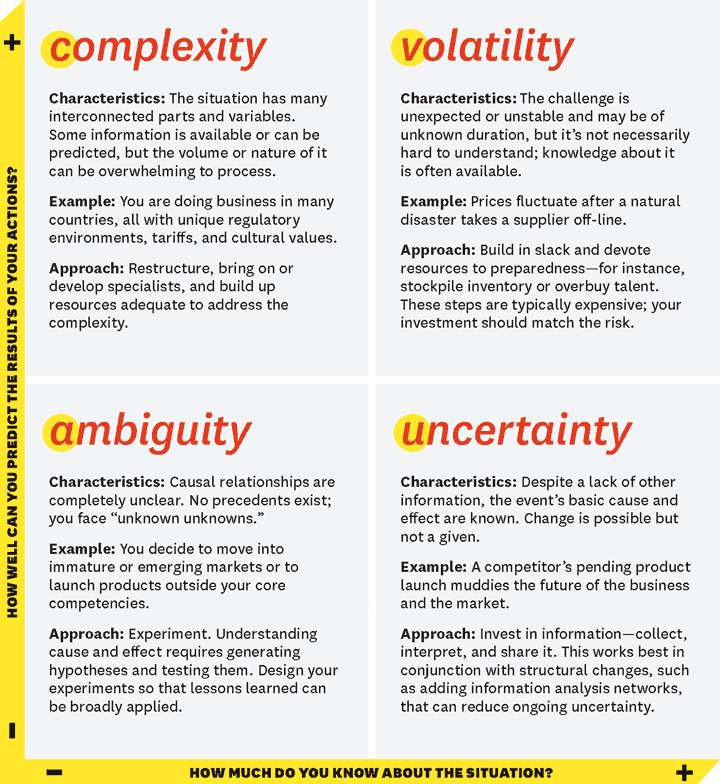As a Corporate Sourcing & Logistics Executive at NBCUniversal, Mark Pierson is responsible for the strategic sourcing of suppliers and the implementation and management of contracts and processes to ensure that NBCUniversal uses efficient and effective logistics and compliance procedures in all of their global operations. These include home entertainment, television and theatrical production and distribution, NBC News, Sports, Olympics, and theme park divisions.
Evidently, NBCUniversal has a tremendously complicated supply chain and one that sources from manufacturing, retail, food services, and more. Risk is inherent in any business, but in a global company with such varied business units, the number of risks to plan for are limitless. Pierson scans the news each morning and uses the VUCA method to classify types of risk and what response they warrant. This method asks two questions:
- How much do you know about the situation?
- How well can you predict the results of your actions?
When Pierson came to the American Supply Chain Summit last year, he shared some of his experience and the supply chain and logistical risks he was facing that week alone in his talk on “Seeing the Big Picture: Gaining Visibility Across your Supply Chain”.

source: HBR, “What VUCA Really Means for You”
VOLATILITY
A volatile situation can be frustrating, but it is not hard to understand. You can plan for it and have a mitigation strategy in place. As Pierson says, “Natural disasters may be impossible to predict, but business disasters can be mitigated if you maintain a robust network of suppliers, distributors and transportation methods.” An example he frequently deals with in his business is fuel surcharges, which are highly volatile. They move in line with oil prices, but predicting where those will go is anybody’s guess.
Balance Volatility with Vision – Consider the possibilities, focus your team’s efforts, and align them in the right areas.
UNCERTAINTY
In an uncertain situation, you know why it is happening but you don’t totally know what will happen. You may lack information, or the information you have could be unreliable. Change is possible but not a given. Pierson gave Brexit as an example. NBCUniversal runs their EU operations from the UK, so they know this will definitely have an effect on how they do business, but the exact impact is yet to be revealed.
Balance Uncertainty with Understanding – Collect as much information as possible, ask questions, keep an open mind, and practice empathy to gain an understanding of how and why other players are making their decisions.
COMPLEXITY
A complex situation has many different variables and it can be difficult to understand them all and how they are interconnected. Maybe you can understand the reason something is happening, you just can’t do anything about it. Pierson gives as an example the April increases in delays for container ships at the Yangshan port near Shanghai. This was the result of new alliances at the port, which cause delays that were then exacerbated by heavy fog. In this situation, he could predict the result, but can’t control another country’s infrastructure.
Balance Complexity with Clarity – Simplify the issue to its core problem and use systems thinking to understand the interdependencies causing the bigger issue.
AMBIGUITY
This is the world of Rumsfeld’s “unknown unknowns”. When a situation is ambiguous there are no precedents and the causal relationships are unclear. What may happen is open to more than one interpretation. He gave as an example here the White House’s announcement in April that they would be outlining their tax reform plan. HBR gives the example of moving into an emerging market or releasing a product outside your core competencies.
Balance Ambiguity with Agility – the ambiguous situation requires you to adapt quickly and be confident. Learn from your mistakes and keep seeking new ways to do things. Empower networks over hierarchy and collaboration over control.
Join the conversation on today’s dynamic supply chain issues at the American Supply Chain Summit! VIEW THE PROGRAM

Comments
hi thanks for the post
An outstanding share! I’ve just forwarded this onto a co-worker who had been doing a little research on this.
And he in fact ordered me dinner simply because I discovered it for him…
lol. So let me reword this…. Thanks for the
meal!! But yeah, thanx for spending time to talk about this matter here on your
blog.